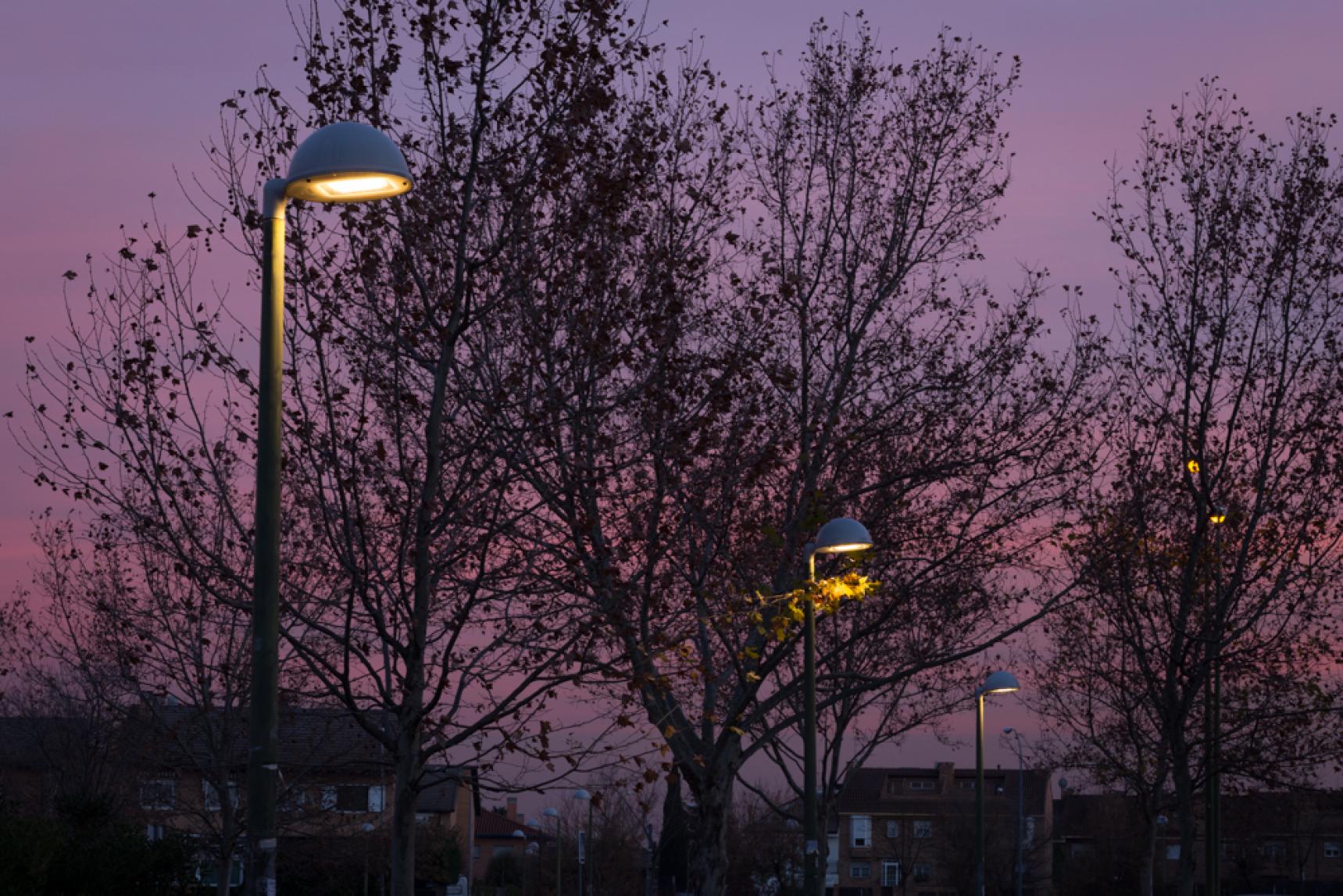In 2013 (and revised in 2015) we published on the IDAE website a report containing the results of the energy audits carried out by the Town Councils which took part in this street lighting assessment within the IDAE assistance programme “Strategy for energy saving and efficiency in Spain 2004/2012- E4”.
In that document, based on the data for the installed base of street lights (number of points of light, installed power, electricity consumption and billing, among others) we obtained ratios that, projected over all of the municipalities registered in Spain, allowed us to estimate the number of points of light and the electrical power consumption of the municipal street lighting in Spain, as presented below:
|
|
IDAE ratios |
Spanish Census |
Results |
||||
|
Size of municipality |
kWh/inhabitant/year |
W/point of light |
Points of light/1000 inhabitants |
Municipalities |
Population |
Gwh/year |
Points of light |
|
>75,000 inhabitants |
81 |
182 |
108 |
88 |
20,399,147 |
1,653 |
2,209,135 |
|
40,001 to 75,000 inhabitants |
118 |
176 |
156 |
76 |
4,239,453 |
501 |
663,381 |
|
10,000 to 40,000 inhabitants |
133 |
163 |
209 |
557 |
10,702,913 |
1,429 |
2,237,499 |
|
<10,000 inhabitants |
169 |
140 |
298 |
7,391 |
9,859,224 |
1,665 |
2,934,665 |
|
Total for Spain |
116.1 |
161.1 |
178.0 |
8,112 |
45,200,737 |
5,247 |
8,044,680 |
Source: IDAE. Compiled in-house.
In May 2015, the IDAE announced a line of financing for projects to reform and renovate municipal street lighting installations, which has made new audits available to us with new data which we can use to review and consolidate the inventory figures as well as analysing the potential for electrical energy savings in these installations.
The assistance programme for the renovation of municipal street lighting (FNEE 2014-2015)
The Official State Bulletin of 5 May 2015 published the regulatory terms and conditions and the call for applications to the programme of assistance for the renovation of municipal street lighting installations, approved by Resolution of the Administrative Council of the IDAE of 24 March 2015, with an initial budget of € 36 million charged to the National Energy Efficiency Fund (FNEE 2014) and later extended by another € 29 million charged to FNEE 2015. This assistance is to finance renovation projects for street lighting in Spanish municipalities based on energy efficiency criteria.
The objective of the programme has been to promote technological reform of street lighting by replacing the lamps with others of greater light efficiency, improving of the reflective and directional quality of the lights, reducing the emission of light to other spaces outside the object of the illumination (light pollution) and implementing systems of regulation of the light flow of the points of light that allow their variation throughout the night according to the population’s needs, as well as the regulation of when they turn on and off.
The economic profitability obtained with the energy savings from this technological renovation allows the investment to be recovered within a reasonable period of time, although the high investment required prevents many Town Councils from undertaking the renovation because they don’t have sufficient budget.
That’s why this programme was designed under the system of interest-free loans and with repayment terms of up to ten years, which makes the execution and amortization of this reform feasible.
The loan could be for up to 100% of the eligible investment, with a maximum value of 4 million euros and a minimum of 300 thousand euros. The loan was not to exceed € 600 per point of light. As stated above, the interest rate was 0.0% and the maximum repayment term 10 years (which includes an initial 12-month period of grace).
The technical requirements for these reforms were:
To reduce the consumption of electrical energy for street lighting by at least 30%.
Regulate lighting levels according to different night-time schedules and types of roads, adjusting them to the needs of the population.
Adapt the existing installations to the precepts established in the Regulation of Energy Efficiency in Street Lighting Installations and to those contained in the Electrotechnical Regulation for Low Voltage.
The energy classification of the new installations must be A or B.
When the reform of the points of light includes the use of LED technology, the provisions of the document “Technical requirements for lights with LED technology for street lighting” prepared by the IDAE and the Spanish Lighting Committee (CEI) must be taken into consideration.
The applicants had to submit, among other documents, a technical report describing the current lighting installation in their municipality, with data and characteristics of equipment, installations and illuminated spaces, their specific consumption ratios and the annual consumption and electrical energy costs, and describing the proposed reform, partial or total, of the said municipal lighting, with the numerical data and the characteristics of the equipment that is planned to be installed and the future scenario assumed for the proposed reforms, and detailing the energy and economic consequences derived from its implementation.
And the information contained in these technical reports has allowed us to update the previously published data. To that end, firstly the results obtained through these assistance programmes are presented.
Results of the assistance programme for the renovation of municipal street lighting (FNEE 2014-2015)
Over the one-year term of this call for applications, 124 correctly completed applications were received for a total of € 142 M, of which 26 were denied for not meeting the requirements of the terms and conditions and a further 3 waived the assistance after it had been approved. Of the remaining 95, 65 cases have been approved for a total of € 64.7 M, leaving the other 30 on the waiting list, since the grant fund is limited to the € 65 M approved with a joint charge to the 2014 and 2015 FNEE.
To date, progress is being made on approving requests from the waiting list. This is not only due to the funds freed-up by the withdrawal of the 3 approved applications, but also by the release of funds due to municipalities’ competitive tenders being awarded to projects at budgets lower than the amount of the loan initially requested. This has represented an average decrease of 19.2% for the 31 municipalities that have already awarded their reforms. (Data on 11/01/2017)
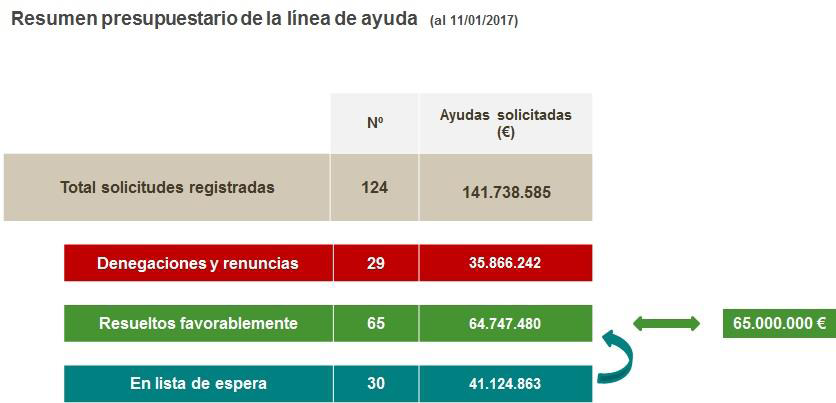
Quantity of the requested loans
The programme’s terms and conditions established that applicants would present their reform proposals together with the implementation cost and the eligible cost that they were requesting as the loan. Obviously, the cost of the reform could be greater than the amount of the loan requested. The following figure shows the profile of the requested loan amounts.
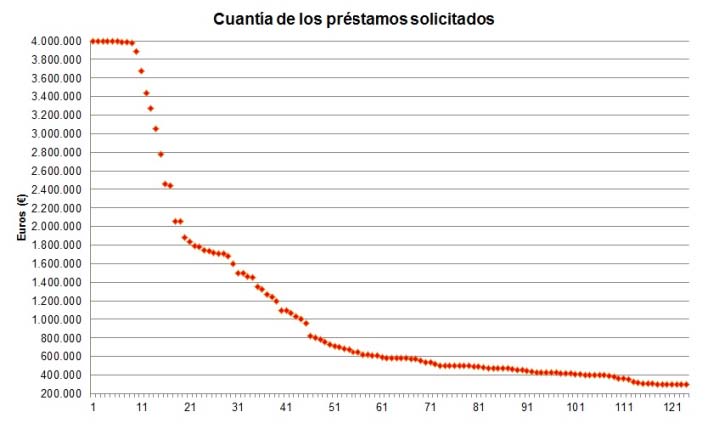
However, the following graph is more informative about the amount of each request depending on the number of points of light to be reformed. This avoids the impact, in absolute terms, that the size of the municipality has on the amount of the loans requested. The average size of the applicant municipalities has been 45,000 inhabitants, with a range from the largest with 787,000 inhabitants to the smallest with 1,100.
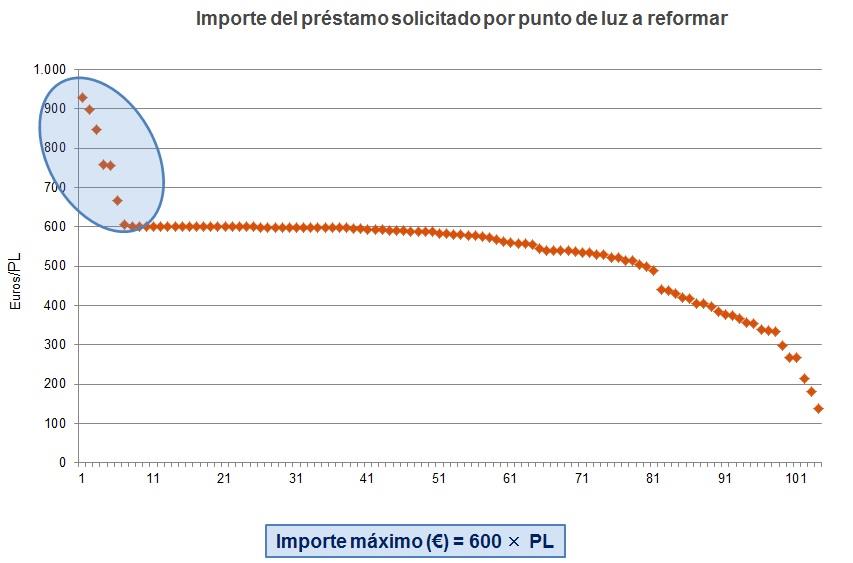
From this representation, it can be seen that most of the applicants adjusted their proposal to the limit of € 600 per point of light, from which they then established the requested loan amount, based on the number of points of light to be reformed. In turn, the graph shows those who, not taking this criterion into account, exceeded the limit of € 600/point of light in their application, which meant their grants were denied for breach of the terms and conditions.
Classification of the applicants’ street-lighting installations
Analysing the characteristics of the municipalities who applied, and those of their street lighting installations, this new sample of 124 applicants brings together a population of 4.37 million inhabitants and 726,647 points of light, representing 9% of the population and, in turn, 9% of Spain’s municipal street lighting.
The following panel shows consolidated figures for the main values obtained from the audits in relation to the lighting installations and their energy consumption and costs, the latter with value added tax. In the lower part of the panel are the global ratios that we consider to be of greatest interest, obtained from each of the audits. Those related to electrical energy consumed per inhabitant and equivalent hours of annual operation are highlighted in red, both figures having a subsequent comment.
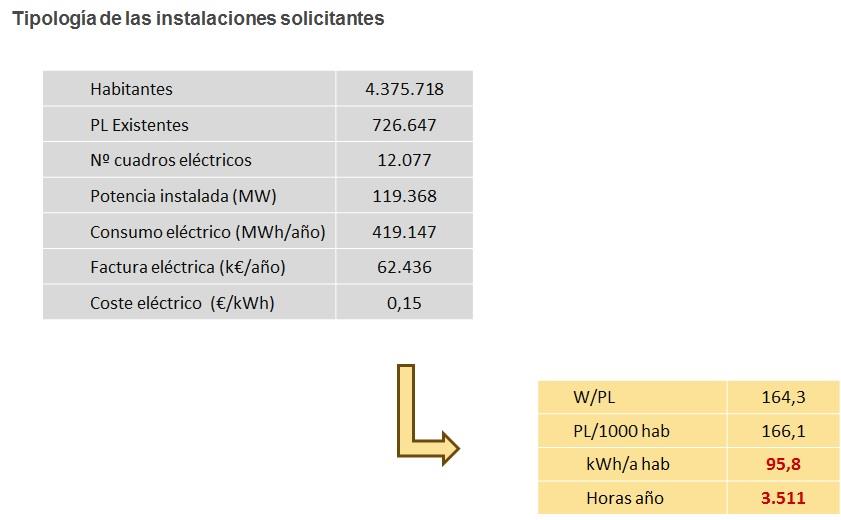
Scope of the proposed reforms
Not all municipalities are undertaking the reform of all their facilities, some because the grant is limited to € 4M, others because their ability to borrow is limited and others because they are undertaking partial reforms of neighbourhoods or complementing actions already underway. With this, of the 726,647 points of light in the applicant municipalities, the reform of 264,045 points of light has been requested. In more than 97% of the cases, reform includes replacement by LED technology, and almost all include the regulation of switching on/off and/or the lighting schedule.
The main energy impact justified by the applicants in their technical report for these reforms is summarized in a saving in electricity consumption of 65% per year. We consider this to be conservative in this phase of proposals for reforms, and we drew conclusions about the reasons for this after observing the value provided in the reports presented for the power of the new points of light, which drops from an average of 164 to 58 W/point of light, that is, the same 65%. This leads us to believe that the additional savings of the flow regulation systems, with which most of the installations will be equipped, and which will add to the final savings, has not been taken into consideration.
Below is a diagram showing these values before and after the proposed reforms:
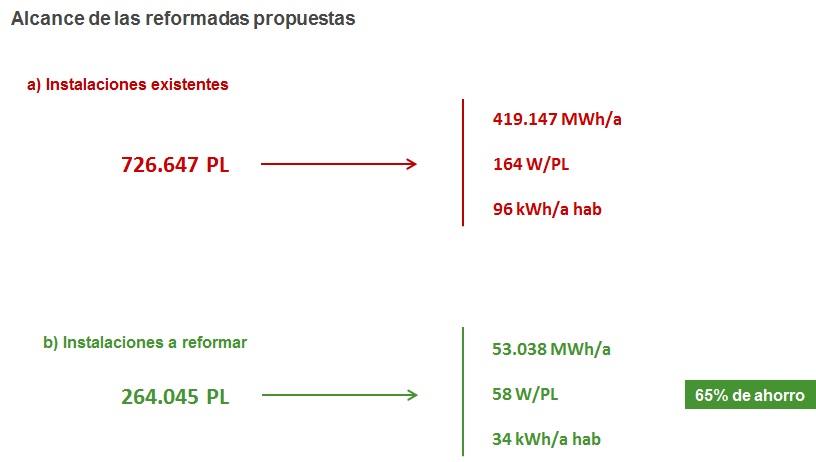
Competitive contracts awarded
At the time of writing, there are 31 applicants who have awarded the contracts to reform their lighting installations, with a global tender for 46,087 points of light and a contract value of € 20,177,941, which represents a average contract award budget of € 438/point of light.
Of this amount, the loan finally provided by IDAE to these beneficiaries totals € 19,753,557, since as mentioned above some beneficiaries have undertaken work for a larger budget than the amount requested as a loan from the IDAE and, in turn, the amount finally lent by IDAE is 19.2% lower than the amount these beneficiaries initially requested in their proposals. As we have already mentioned, although many applicants had adhered to the grant limit of € 600/point of light established as the maximum in the terms and conditions, the reality is that in many cases the contracts were awarded at a bid value lower than this amount. At this point, it should be noted that some beneficiaries, instead of prioritizing low costs in their competitive tenders, have requested bidders to maintain the maximum tender budget and to value an increase of the number of points of light to be reformed. This situation has also been taken into account in calculating these ratios.
The summary table of these 31 competitive tenders and their impact on the IDAE’s grant programme is as follows:
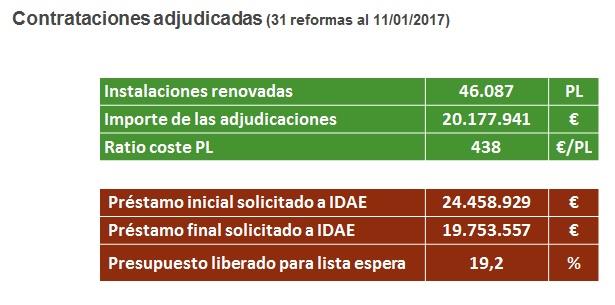
Maintenance costs
Finally, and although if it doesn’t influence the current analysis, the data provided by the applicants regarding the costs of maintenance and conservation of their street lighting installations is presented. In total, we have made available the cost declaration of 54 municipalities with an installed base of 455,879 points of light and a cost of € 13,724,200 per year, which represents an average annual maintenance cost of € 30.10/point of light. (The figures include value added tax).
These values range from € 64.40 per point of light per year for external contracts that undertake (among other tasks of monitoring and supervision) the regular tasks of cleaning the lights, down to € 3.90 per point of light per year for municipalities that perform almost exclusively corrective maintenance and do so using their own personnel. The profile of these declarations of costs is represented on the graph.
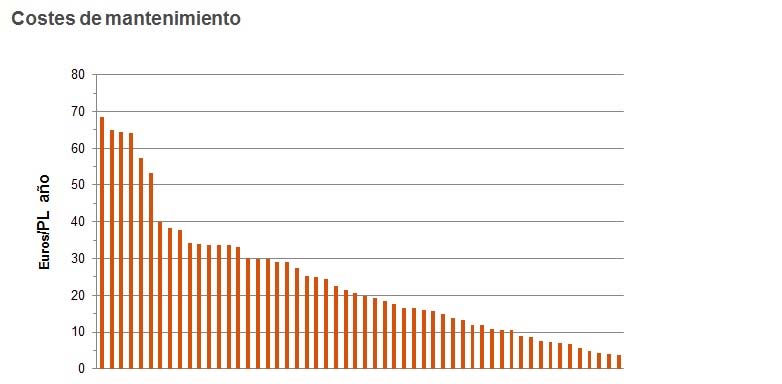
Inventory and energy consumption of the municipal street lighting in Spain
As already indicated, based on the information contained in the energy audits relative to the population, the number of light points, the installed power and the annual electricity consumption of these installations, ratios are obtained which allow us to calculate the inventory of these lighting installations, and their associated electricity consumption, for the whole of Spain. The methodology is to apply these ratios to every municipality included in the census of municipalities and population of Spain.
In the inventory of 2013/2015, the results were grouped by steps of 75,000, 40,000 and 10,000 inhabitants, these steps having no more justification than mere chance in terms of the population grouping of the first municipalities that were studied. On this occasion, having a larger sample after adding these new audits to the originals, we can expand the number of these groupings without fear of creating uncertainties due to the lack of partial data. Therefore, the new steps chosen have been 75,000, 40,000, 20,000, 10,000 and 5,000, which allows us to obtain a more uniform and disaggregated view of the street lighting installations in our country.
|
|
IDAE Ratios 2017 |
Spanish Census 2016 |
Results |
||||
|
Size of municipality |
kWh/inhabitant/year |
W/point of light |
Points of light/1000 inhabitants |
Municipalities |
Population |
Gwh/year |
Points of light |
|
>75,000 inhabitants |
82 |
179 |
120 |
98 |
21,525,605 |
1,760 |
2,588,324 |
|
40,001 to 75,000 inhabitants |
112 |
172 |
153 |
77 |
4,204,804 |
471 |
642,952 |
|
20,001 to 40,000 inhabitants |
114 |
161 |
189 |
227 |
6,248,522 |
713 |
1,183,382 |
|
10,001 to 20,000 inhabitants |
139 |
155 |
229 |
347 |
4,914,991 |
682 |
1,124,529 |
|
5,000 to 10,000 inhabitants |
151 |
137 |
280 |
551 |
3,869,029 |
586 |
1,084,126 |
|
<5,000 inhabitants |
1687 |
131 |
384 |
6,825 |
5,794,057 |
1,085 |
2,226,526 |
|
Total for Spain |
114 |
156 |
190 |
8,125 |
46,557,008 |
5,296 |
8,849,839 |
Source: IDAE. In-house compilation 2017
We want to note two observations about these results that justify their slight difference from those of the 2013/2015 inventory:
- The census used has been updated, and in the year 2016 the country grew by 3% compared to the census used previously, that of 2008, which was our base used with the work of the E4 Action Plan 2008/2012.
- As already noted in the first report, access to the information from small municipalities has revealed a huge installed base of street lighting in these locations, which was not detected by other works and publications that were prepared with information from large and medium municipalities. If we look at the variation in the ratio of points of light per capita for the different sizes of municipalities shown in the table, along with the population living in the small ones, the slight increase obtained is justified because the sample of these small municipalities has expanded.
In conclusion, the expansion of the database obtained thanks to this programme has allowed us not only to optimize but also to consolidate the results that we had established in the previous inventory.
If we accept and continue to project these ratios of points of light and per capita consumption of street lighting for each of the municipalities in the census, and group them by Autonomous Community, we obtain the following estimate:
|
Autonomous Communities |
Population 2016 |
No. points of light |
MWh/year |
|---|---|---|---|
|
Andalusia |
8,388,107 |
1,584,697 |
952,839 |
|
Aragon |
1,308,563 |
275,558 |
157,696 |
|
The Balearic Islands |
1,107,220 |
204,089 |
125,136 |
|
The Canary Islands |
2,101,924 |
360,613 |
226,280 |
|
Cantabria |
582,206 |
131,019 |
74,550 |
|
Castile La Mancha |
2,041,631 |
510,849 |
282,176 |
|
Castile and León |
2,447,519 |
586,482 |
324,575 |
|
Catalonia |
7,522,596 |
1,392,053 |
841,918 |
|
Ceuta |
84,519 |
10,152 |
6,927 |
|
Valencia |
4,959,968 |
941,478 |
568,598 |
|
Extremadura |
1,087,778 |
280,869 |
152,983 |
|
Galicia |
2,718,525 |
587,417 |
338,158 |
|
Madrid |
6,466,996 |
910,409 |
597,674 |
|
Melilla |
86,026 |
10,333 |
7,050 |
|
Murcia |
1,464,847 |
236,556 |
150,463 |
|
Navarra |
640,647 |
158,385 |
86,735 |
|
The Basque Country |
2,189,534 |
418,648 |
251,641 |
|
Asturias |
1,042,608 |
181,701 |
112,412 |
|
La Rioja |
315,794 |
68,531 |
38,718 |
|
Total |
46,557,008 |
8,849,839 |
5,296,530 |
Source: IDAE. In-house compilation 2017
Energy consumption and potential for energy saving
Determining the consumption and energy saving potential of these installations is more complex than the method previously used to discover the number of points of light, since there is uncertainty. This is due, on the one hand, to the number of lighting hours and, on the other, to the type of light source used. Both parameters have changed significantly in recent years.
a) Regarding the use of these installations, in the audits that we prepared for the 2013/2015 inventory, the average number of equivalent hours of annual lighting (the result of dividing the annual electricity consumption of each municipality by its installed power), was 4,098 hours while the average resulting from the audits presented to the programme of grants charged to the FNEE in this last year has resulted in 3,511 hours, which means a reduction in consumption of 14.3%. Given that these audits belong, by definition, to installations that are going to be reformed, the reasons stated in, or deduced from, the audits themselves give three causes: the introduction and use of flow regulation systems in the head and the optimization of switching lights on and off (going to the limits of after dark and before dawn); sectorization in roads and other spaces through partial shutdowns, and cable theft (in a few cases).
b) Regarding the source of light, it’s evident that in recent years many lighting reforms, total or partial, have been undertaken in many municipalities, being mostly LED. These changes represent savings that will be in a range between 65% and 80%, reforms of which we are not aware in IDAE as they were carried out without the need for grants, since they are direct actions of the local councils using their own resources or through third-party financing.
Both facts prevent us from establishing whether the consumption determined in the inventory of 5,296 GWh/year as a result of projecting the ratios of the audits onto the whole country (audits covering 21% of the street lighting in Spain, which for other market studies would be a highly sufficient sample) may or may not give a good approximation to reality. It is left to the reader’s skill and judgement to assess with sufficient approximation the value of this consumption figure.
What is of course beyond question is the potential for savings in these installations. On the one hand, the applicants for this programme have presented reforms that will allow them to obtain minimum savings of 65%. On the other hand, the various projects undertaken with the participation of the IDAE, as well as others executed by third parties and publicised in the media, show savings of over 80% when combining LED with the scheduled regulation of flows. These figures, which would be extraordinary in the reform of other types of energy consumption installations, mean that this sector, which is currently immersed in a technological change, is rapidly moving towards energy consumption values that are difficult to determine at this moment.



